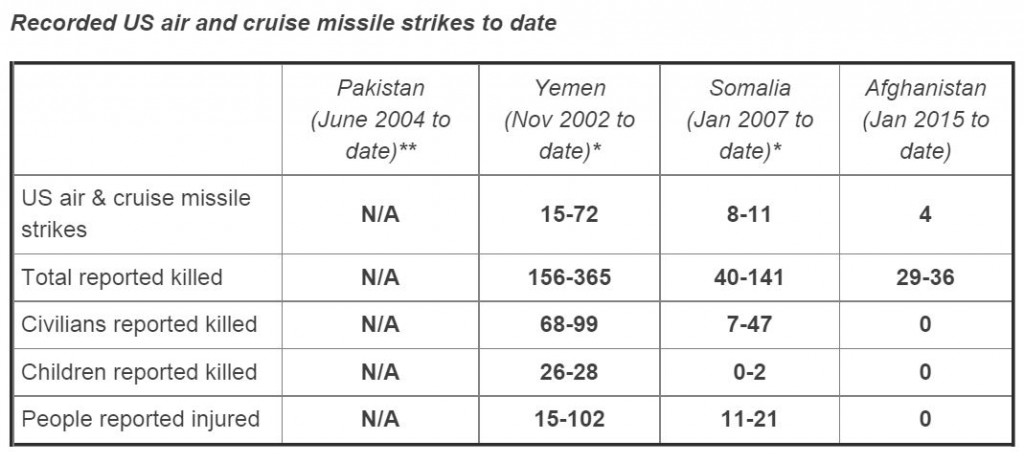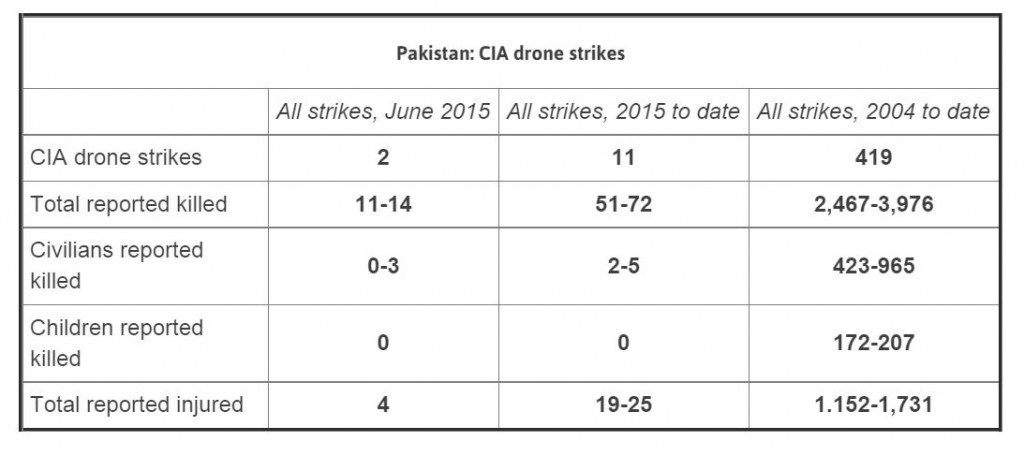US Drone Warfare: Controversial ‘Signature Strikes’ Hit Yemen and Pakistan
The Bureau of Investigative Journalism's Report, January – June 2015

Image: President Barack Obama publicly acknowledged a specific drone strike in Pakistan, an unprecedented step. He apologized for killing American Warren Weinstein and Italian Giovanni Lo Porto, two al Qaeda hostages, in a signature strike in Pakistan (Photo: White House)
US drone and air strikes killed at least 207 people in Pakistan, Afghanistan, Somalia and Yemen so far in 2015, according to data collected by the Bureau.
The strikes left 52 dead in June alone. Last month there were two confirmed US strikes in Pakistan and Yemen, and four in Afghanistan.
CIA drones have been striking in Pakistan at a rate of around two per month for the past two years. After an intense start to the year, with five attacks reported in January, the strikes have become more occasional with none reported in February, one in March and April, and two in May and June.
i. Key points:
- Signature strikes return to Pakistan and Yemen.
- First confirmed civilian casualties since 2012 in Pakistan.
- Drone strikes persist in Yemen despite catastrophic civil war.
- More than 100 people killed in US air strikes in Afghanistan.
- Al Shabaab attacks continue in Somalia despite losing leaders in drone strikes.
ii. The Bureau’s numbers:
Recorded US drone strikes to date
Recorded US air and cruise missile strikes to date
* The Bureau’s estimates are based predominantly on information from open sources like media reports. Sometimes it is not possible to reconcile details in different reports. This is why we use ranges for our record of casualties and, in the case of Yemen and Somalia, our strike tallies.
** In Pakistan the US has only carried out drone strikes.
iii. Bureau analysis for the first half of 2015:
US drone and air strikes killed at least 207 people in Pakistan, Afghanistan, Somalia and Yemen so far in 2015, according to data collected by the Bureau.
The strikes left 52 dead in June alone. Last month there were two confirmed US strikes in Pakistan and Yemen, and four in Afghanistan.
CIA drones have been striking in Pakistan at a rate of around two per month for the past two years. After an intense start to the year, with five attacks reported in January, the strikes have become more occasional with none reported in February, one in March and April, and two in May and June.
This year Yemen has sunk into a civil war. Despite this, on January 25 President Barack Obama said the crisis would not affect the US’ counter-terrorism tactics. The US punctuated this statement with drone strikes on January 26, January 31 and February 2. There was then a pause for more than two months in Yemen.
The attacks abated as the Shia Houthi militia forced the government into exile and began taking control of major cities in the west of the country. Saudi Arabia began bombing Yemen in an as-yet fruitless effort to halt the Houthi advance.
The drone strikes returned in April in response to al Qaeda in the Arabian Peninsula (AQAP) exploiting the crisis and taking control of the city of Mukalla in the east of the country.
Two strikes in the past six months are of particular note. Both were signature strikes – targeted at men who had been judged as al Qaeda based on their observed patterns of behaviour rather than their actual identities.
In January, the US killed two al Qaeda hostages, an American and an Italian, in Pakistan. The attack was aimed at a building housing four unnamed targets – correctly determined to be al Qaeda fighters by their observed patterns of behaviour.
Unbeknownst to the CIA, the two hostages were being held in the same building. It took the Agency several weeks to determine it had killed the two civilians in the attack.

US government
Another CIA drone strike, this time in Yemen, also appeared to be a signature strike. It killed AQAP’s commander, Nasser al Wuhayshi (right).
Unnamed “US officials familiar with the situation” told Bloomberg the CIA had tracked al Wuhayshi and targeted him in the attack. Other unnamed US officials, however, told the Washington Post they did not know al Wuhayshi was in the car when the drones struck.
The CIA has not commented on the strike, however the timeline of events leading to the White House declaring al Wuhayshi dead suggests this was indeed a signature strike. CNN first reported his death, citing two unnamed Yemeni officials. A US official told the broadcaster America was reviewing its intelligence to see if they had killed him. It was only after AQAP itself declared Wuhayshi dead that the US came out with its own statement.
Country Reports
1. Pakistan
The CIA’s drone campaign continued in Pakistan with two strikes killing 11-14 people in the first week of June.
Four or five people were killed in a strike on the Shawal area of North Waziristan on June 1. Five days later drones reportedly hit the Shawal again, killing 7-9 people. Tribal and security sources told The News three women were among the dead. Another unnamed official told the paper fighters had their families with them “and it is possible the drone killed women as well.” None of the people killed last month have been identified.
June also saw the one year anniversary of the beginning of the Pakistani offensive in North Waziristan. The Pakistani military began air strikes in June 2014, gradually putting ground troops into the tribal agency as the second half of the year progressed. Thousands of militants have been killed since, according to the Pakistani military information service ISPR. However it is impossible to verify these claims as the army is not allowing journalists into the area and telecoms have reportedly been disrupted in some areas. This is also affecting the flow of information relating to drone strikes.
Six month analysis
All the CIA drone strikes so far this year have damaged or destroyed domestic buildings. And 10 of the 11 strikes have reportedly hit in the Shawal area of North Waziristan.
The Shawal is a forested area of steep valleys. This inhospitable region straddles the North-South Waziristan border, and the Afghan-Pakistan border. It has long been a stronghold for smugglers and armed groups. It is one of the last Taliban bastions to be taken by Pakistani ground forces in the military’s ongoing offensive.

The rate of strikes in Pakistan could be reaching a stable point after falling from the peak of the campaign in the second half of 2010. The first and second halves of 2013, and the second half of last year saw strike hit at a rate of around two per month.
The exception is the first half of 2014 when attacks stopped entirely for more than five months while the Pakistan government tried and ultimately failed to negotiate a peace deal with the Pakistan Taliban. Three drone strikes hit in June, after the Pakistan military had begun its now year-long military operation in North Waziristan.

Two al Qaeda hostages, American Warren Weinstein and Italian Giovanni Lo Porto, were accidentally killed in a signature in January. They were the first confirmed civilians to die since the second half of 2012. However in the intervening 25 months, the Bureau has collected reports of up to 14 civilians dying in six drone strikes.

US aid worker Warren Weinstein ,73 (Photo: from Al Qaeda propaganda video)
2. Afghanistan
The Bureau has been collecting data on US air and drone strikes in Afghanistan since the start of January this year. In this period, June has been the deadliest month yet recorded.
There have been eight confirmed US attacks that have killed 50-89 people, including at least 14 civilians.
The first two confirmed US attacks, on June 5 and June 8, reportedly killed civilians. The first hit a convoy of vehicles leaving a funeral in Khost province. The attack either killed 34 insurgents who had just buried a senior Taliban commander. Or it killed 14-29 civilian members of the Kuchi tribe who had buried a tribal elder.
The US said it had attacked armed militants in Khost and that reports of civilian casualties were being investigated.
The second attack hit three days later and killed seven people. One was identified as Spargahy, a local Taliban commander. Up to six of the dead were said to be high school students who had been taken for military training. It was not clear what age they were or whether they were taken by force.
The third and fourth strikes killed 13-15 people, including up to seven named alleged Taliban insurgents. There were three US air strikes reported at the end of the month, hitting Nuristan and Paktika province. The Taliban had reportedly fought fierce battles with the Afghan army in the days before the US attacks. The Taliban briefly took control of the province’s Want Waygal district on June 26. The insurgents were pushed out of the area the same day and US air attack killed five in that district on June 27.
The final strike of the month hit on June 30 in Nangarhar province, killing between four and 14 people – all reportedly insurgents. The attack hit after Reuters revealed fighters who claimed loyalty to the Islamic State had pushed the Taliban out of six of the 21 districts in Nangarhar.
Taliban violence continued last month with an attack on the parliament in Kabul. A suicide car bomb breached the wall of the complex and shook the parliament chamber itself. Gunmen stormed the building but were killed by security forces, before they could kill or take hostage any MPs.
The first six months of the year have been particularly bloody for Afghan civilians. As of April 30, 978 civilians had been killed in the ongoing conflict, according to Mark Bowden, the UN Secretary-General’s deputy special representative in the country.
This translates as 245 people killed per month. In 2014, 308 civilians died per month. However, with violence becoming more intense in Afghanistan through May and June, it seems likely 2015 will be at least as lethal for Afghan civilians.
“[Doctors] told me that they are seeing a 50 per cent increase in the number of civilians injured this year compared to the same period last year,” Bowden added.
Fighting continues in the north of the country around the city of Kunduz. The Taliban has advanced on the city and been beaten back by the Afghan army on several occasions this year.
During the latest round of fighting, the Afghan forces reportedly called on the US for air support though none was forthcoming, according to the Washington Post.
3. Yemen
* All but one of these actions have taken place during Obama’s presidency. Reports of incidents in Yemen often conflate individual strikes. The range we have recorded in US drone strikes and covert operations reflects this.
Two confirmed drone strikes killed 7-8 people in June, almost replicating the picture in May when two attacks killed 6-8 people.
The first strike in June killed Nasser al Wuhayshi, the leader of AQAP and second in command of al Qaeda overall.
Wuhayshi had been a leading figure in al Qaeda since the 1990s when in Afghanistan he became Osama bin Laden’s personal secretary. He rose to prominence in the Yemen branch of the terrorist group in 2007 and in January 2009 publicly declared himself the leader of AQAP – an amalgamation of Al Qaeda in Yemen and Al Qaeda in Saudi Arabia.
Wuhayshi had led AQAP since it was formed in 2009 out of the remnants of al Qaeda in Saudi Arabia and al Qaeda in Yemen, which he led since 2007. He had been deputy leader of al Qaeda and Ayman al Zawahiri’s deputy since 2013.
The second strike killed four or five people on June 24. A vehicle was reportedly targeted on the outskirts of Mukalla, in a former army base that AQAP had taken over when they took control of the city in April.
June was the third month of an ongoing Saudi Arabian bombing campaign in Yemen. The strikes are trying to halt the advancing Houthis, a Shia militia, who drove President Abdu-Rabbo Mansour Hadi into exile in Riyadh in March.
Hadi was ensconced as president in 2011 by the US and its Gulf allies in 2012 after a popular uprising ousted his predecessor, dictator Ali Abdullah Saleh. Forces loyal to Hadi and his Gulf supporters are fighting the Houthis who have allied themselves with Saleh’s militias. Militias associated with southern secessionists have taken up arms against the Houthis though are adamant this does not mean they are aligned with Hadi.
Thousands of people have been killed by the civil war and Saudi air campaign. Atrocities have been reported on all sides. Saudi Arabia and its allies are stopping aid supplies from entering the country by sea and air. Houthi forces have besieged the second city of Aden. Vital infrastructure has been destroyed, food is scare, disease rife. The UN says the country is one step from famine and 31 million people require humanitarian aid.
There have been 12 drone strikes so far in 2015, more than in any six month period since the second half of 2012 when 14 drone strikes hit the country. This frequency of attacks is surprising considering Yemen has been riven by civil conflict for most of the past six months.
The increase in the rate of attacks is in part because in April AQAP took advantage of Yemen’s crisis. Its forces swept into Mukalla, the capital of Hadramout province, establishing themselves as the new authority. Four strikes hit in April and since April 12 five of the nine drone strikes have hit Mukalla.
The US drones have not been this focused on a single town or city before now, according to the Bureau’s data. The US did focus its efforts on the Abyan governorate in the second half of 2011 and into 2012. This was in response to AQAP exploiting another period of instability in Yemen to take control of most of the area in and around the governorate, declaring it an Islamic Emirate.
While the number of strikes has been going up, the casualty rate has fallen with fewer people dying per strike in the first half of 2015 than any six month period since the first half of 2013.
The attacks in the past six months have killed a number of named, senior figures in the group. Besides Nasser al Wuhayshi, killed in a signature strike in June, the drones have killed one of AQAP’s key ideologues, Nasser al Ansi, and its chief spokesman, Mohanned Ghallab.
The attacks also killed Ibrahim al Rubaish, a senior AQAP figure, and Sheikh Harith al Nadhari, a leading ideologue who released a statement praising the Charlie Hebdo attack in Paris.
4. Somalia
June passed without a reported US attack on al Shabaab. However this month the group released pictures of a US surveillance drone it said crashed in May.
Crowds gather in #AlShabab HQs in Dinsor town to view possible US surveillance drone the group said crashed on May 17 pic.twitter.com/14fYHkRHy4
— Harun Maruf (@HarunMaruf) June 5, 2015
There were two confirmed drone strikes in Somalia in the past six months. In a country where such attacks are rare, this represents a high intensity of operations
The strikes continued the trend seen in both the first and second halves of 2014, targeting senior figures in al Shabaab. In March a US special forces drones killed Adnan Garaar, a senior member of al Shabaab’s Amniyatt intelligence service. He reportedly replaced Ysusuf Dheeq as head of the group’s external operations. Dheeq was killed in a drone strike in February this year.
There were two confirmed drone strikes in the second half of last year – both killed senior al Shabaab figures. The first, on September 1, killed the group’s supreme leader, Ahmed Abdi Godane.
Taking out these senior figures appears not to have blunted al Shabaab’s capacity for extreme violence. It has attacked supposedly secure buildings in the fortified government district of Mogadishu. It has assassinated MPs and senior officials.
This year the group committed its worst atrocity to date. Its gunmen murdered 148 students as they slept in their dormitories at Garissa university in northeastern Kenya.
In May, Somalia expert Matt Bryden published a report that explained how al Shabaab was still a potent, transnational terrorist threat, despite having lost leaders to the drones and territory in Somalia to African Union peacekeepers.








